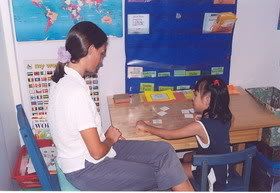There were basically two different common methods of teaching reading. One usually refers to whole word approach ("look say"), the other usually refers to phonetics approach. More recently, a new approach called Whole language has been advocated
Look-say
Look-say
The "look say" method also known as the whole word, sight method, or configurational reading is a 'spatial-holistic' method to learn a language. It is the same method used to acquire literacy in languages such as Chinese, based on ideograms. Its application to learning a primarily phonetic language like English has questionable value and has been associated with artificially inducing dyslexia.

Students when learning English using this method memorize the appearance of words, or learn to recognize words by looking at the first and last letter from rigidly selected vocabularies in progressive texts (such as The Cat in the Hat). Often this method is taught by slides or cards with a picture next to a word, teaching children to associate the whole word with its meaning. Often preliminary results show children taught with this method have higher reading levels than children learning a phonetic method, because they learn to automatically recognise a small selection of words. However later tests demonstrate that literacy development becomes stunted when hit with longer and more complex words later in school life. It is known that "look say" students do not naturally learn to spell or write unless explicitly taught because they have not learnt to pronounce words phonetically; they are encouraged to guess them instead. However, they can learn the 5,000 most common words in roughly three years which is sufficient for basic literacy. The classic implementation of this approach was the McGill reading curriculum used to teach most baby boomers to read in the U.S.


No comments:
Post a Comment